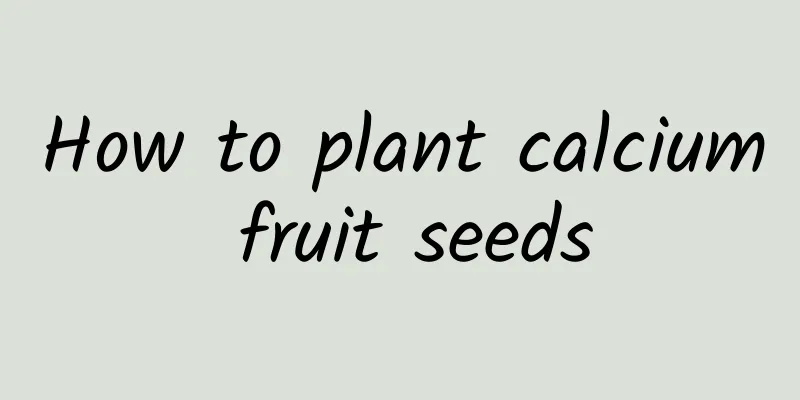What nutrients are missing if papaya fruit does not grow large?

|
Papaya is a shrub belonging to the Rosaceae family. There are many varieties of papaya, and different varieties of papaya are different in size. Generally speaking, papaya blooms mainly around April every year, and the fruit matures usually from September to October every year. Some farmers encounter the problem that the papaya fruit does not grow big when planting it. So what nutrients are missing that cause the papaya fruit to not grow big? Let’s take a look below. 1. Lack of major nutrients 1. Potash fertilizer Potassium is an activator of various enzymes in plants and plays an important role in plant growth, development and metabolism. Lack of potassium fertilizer will cause papaya fruit to grow slowly, become smaller in size, and have reduced quality. Therefore, during the growth of papaya, potassium fertilizer should be applied in time to promote the enlargement of the fruit and improve its quality. 2. Phosphate fertilizer Phosphorus is an important component of plant cells and has a significant impact on plant root development, flower and fruit formation, and fruit quality. Insufficient phosphorus fertilizer will cause poor development of the papaya root system, reduced number of flowers and fruits, and small fruits with poor quality. Therefore, the proportion of phosphorus fertilizer should be appropriately increased in the base fertilizer and topdressing of papaya. 3. Nitrogen fertilizer Nitrogen is a basic element for life substances such as proteins and nucleic acids in plants and is essential for plant growth and development. However, too much nitrogen fertilizer will cause the papaya plant to grow too tall and affect the normal development of the fruit; insufficient nitrogen fertilizer will cause the plant to grow slowly, and the fruit will be small and of poor quality. Therefore, the amount of nitrogen fertilizer should be controlled during the fertilization process to ensure reasonable fertilization. 2. Lack of trace elements In addition to the main nutrients, papaya may also lack some trace elements, such as calcium, magnesium, zinc, boron, etc. Although these trace elements are present in very small amounts in plants, they play an irreplaceable role in plant growth and development and the quality of their fruits. The lack of these trace elements can lead to problems such as poor development, deformity, and reduced quality of papaya fruits. Therefore, during the fertilization process, attention should be paid to supplementing these trace elements to meet the needs of papaya growth and development. 3. Solution 1. Reasonable fertilization Develop a scientific fertilization plan based on the growth habits and fertilizer requirements of papaya. Apply sufficient amount of organic fertilizer and compound fertilizer in the base fertilizer to provide comprehensive nutrition for the growth of papaya; apply potassium fertilizer, phosphorus fertilizer and nitrogen fertilizer in time during the growth and fruiting period to meet the needs of papaya at different growth stages. 2. Foliar spraying During the growth process of papaya, the nutrients needed by the plant can be quickly supplemented by spraying fertilizer on the leaves. Especially during the papaya fruit enlargement period, you can spray some foliar fertilizers containing potassium, phosphorus and other elements to promote the enlargement of the fruit and improve its quality. 3. Strengthen field management In addition to fertilization, field management of papaya should also be strengthened, including timely watering, drainage, weeding, loosening soil, pruning, etc. These measures can improve the growth environment of papaya, increase soil fertility, promote the growth and development of papaya and improve the quality of the fruit. To sum up, the reason why papaya fruit does not grow well is probably due to a lack of potassium fertilizer, phosphorus fertilizer, nitrogen fertilizer, and trace elements such as calcium, magnesium, zinc, and boron. In order to solve this problem, we need to apply fertilizer reasonably, spray fertilizer on leaves and strengthen field management to provide comprehensive nutrition and a good growth environment for papaya.
|
>>: What do turtles eat and how to feed them
Recommend
How to propagate cycad seedlings? Can cycad seeds be grown into seedlings?
The Chinese name of Cycas revoluta is Cycas revol...
How to eat passion fruit
How to eat passion fruit Method 1: Fresh food Use...
How to grow taro to get high yield?
Taro, also known as green taro, taro, hairy taro,...
How to plant small-fruited rose in pots
Select container The plant may grow quite tall, r...
Featherleaf lavender cutting propagation method
Featherleaf lavender cutting propagation time The...
Camellia cultivation methods and precautions
1. Flower Pot When planting camellia in pots, the...
How to sow poppy
Sowing method Poppy is suitable for open-field di...
Where are the best places to grow black apples?
Black apple planting conditions Black apples have...
Does geranium prefer shade or sun?
Does geranium prefer shade or sun? Geranium is ve...
When is the best time to plant cherries?
Cherry planting time Cherry belongs to the genus ...
Is growing mushrooms profitable? Growing costs and profits
Is growing mushrooms profitable? Previously, many...
When is the best time to eat hawthorn? How to eat hawthorn?
1. When is the best time to eat Hawthorn is a com...
How to grow Boston fern
1. Temperature It has a certain degree of high te...
By the Erhai Lake, in the Moon Palace, she created a paradise with her heart
On the shore of Erhai Lake, Build an exquisite an...
Eggplant seed germination method common germination seedling raising technology
Germination of eggplant seeds refers to the proce...









